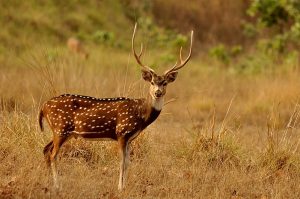ForumIAS announcing GS Foundation Program for UPSC CSE 2025-26 from 19 April. Click Here for more information.
ForumIAS Answer Writing Focus Group (AWFG) for Mains 2024 commencing from 24th June 2024. The Entrance Test for the program will be held on 28th April 2024 at 9 AM. To know more about the program visit: https://forumias.com/blog/awfg2024
Source-This post on Spotted Deer has been created based on the article “40 spotted deer translocated from Mysuru Zoo to Kali Tiger Reserve” published in “Deccan Herald” on 22 February 2024.
Why in the news?
Recently, 40 spotted deer (axis axis) have been translocated from Chamarajendra Zoological Gardens (Mysuru Zoo) to Panasoli range of Kali Tiger Reserve (KTR) in Dandeli forest, Uttara Kannada district.
What is spotted deer?

| Aspect | Details |
| About | 1. The Axis Deer, also known as Chital or Spotted Deer. 2. It is a large species of deer, which has a particularly elegant and charming appearance. 3. Axis Deer are crepuscular, which means that they are most active during the dawn and dusk. |
| Distribution | It is native to the Indian subcontinent (India, Nepal, Sri Lanka, Bhutan, and Bangladesh). |
| Habitat | 1. They primarily eat grasses and vegetation but will also ingest their shed antlers as a source of nutrients. 2. These deer prefer moderate to dense forests and grasslands near water sources. |
| Conservation Status | IUCN: Endangered |
| Characteristics | 1.Lifespan- About 20 to 30 years. 2. Height and weight- It stands at about 35 inches tall and weighs about 187 pounds. 3. Appearance- The deer’s golden-Rufus colouring is speckled with white spots, and it has a white underbelly. 4. Reproduction- The spotted deer has a prolonged mating season, as the perpetually warm climate allows females to remain fertile and to give birth to fawns any time of year. 5. Herd size- Spotted deer most commonly occur in herds of 10 to 50 individuals, with one or two males and a number of females and young. |
About Kali Tiger reserve
| Aspect | Details |
| Introduction | 1. The forest in the area was declared the Dandeli Wildlife Sanctuary on 10 May 1956. 2. The state proposed carving out a section of the sanctuary to form the Anshi national park, which was implemented on 2 September 1987. 3. It was renamed to Kali Tiger Reserve in December 2015 |
| Location | Kali Tiger Reserve, earlier known as Dandeli-Anshi Tiger Reserve, is located in the central portion of the Uttara Kannada (North Canara) district of Karnataka state. The Tiger Reserve comprises two important protected areas of the region viz., Dandeli Wildlife Sanctuary (475.018 Km²) and Anshi National Park (339.866 Km²). |
| Vegetation | Forests of the Tiger Reserve are primarily moist deciduous and semi-evergreen, with excellent patches of evergreen forests in the westernmost parts as well as in deep valleys. |
| Rivers | The Kali River flows through the tiger reserve and is the lifeline of the ecosystem. |
| Fauna | Animals found in the Tiger Reserve include Tiger, Leopard, Elephant, Bison, Wild dog, Sambar, Spotted deer, Sloth bear, Wild boar, Hanuman langur, Bonnet macaque, varieties of reptiles and birds including all four species of hornbills as its residents., etc. Kali Tiger Reserve is home to rare black panthers. |
UPSC Syllabus- Environment/National Parks/Species in News




